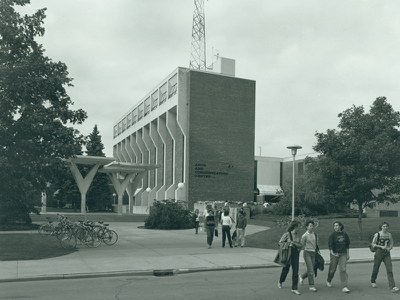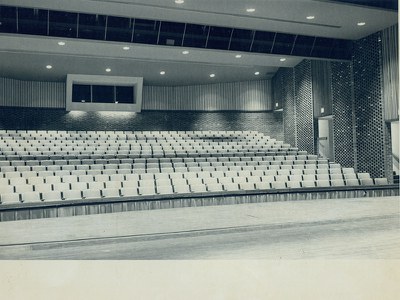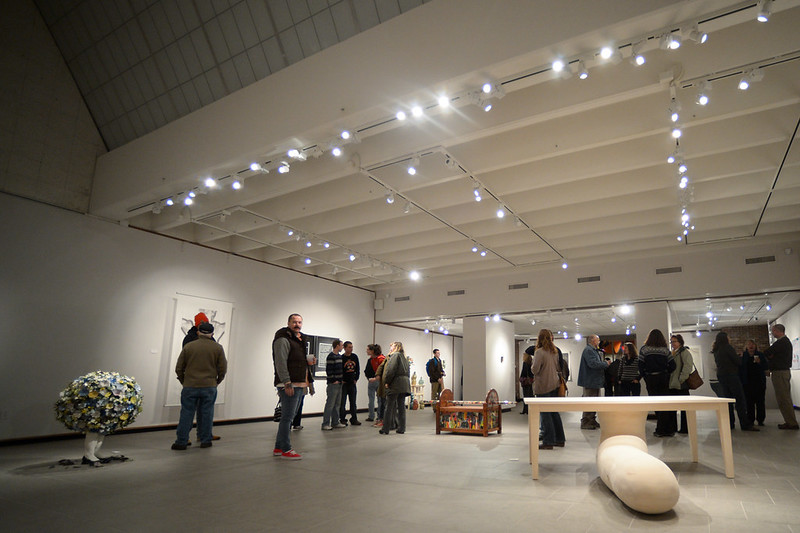Arts and Communications Center and Theatre Arts Center
Name
The Arts and Communication Center was so named to identify the various departments it served rather than highlight a specific person associated with the University’s history. The building was first called the Fine Arts Building but, by late 1971, was renamed the Arts and Communications building.
Art Gallery Namesake: Allen J. Priebe
Priebe joined the University’s teaching staff in 1953 and served in the Art Department until his death in 1965.
Theatre Original Namesake: Racine-born actor, Fredric March.
A committee of communications faculty was charged to name the new theatre. The committee wanted a name with strong Wisconsin ties. In addition to other names, they considered Alfred Lunt and Lynn Fontaine, but that was rumored to be the name of UW Madison’s new theater (it was not). The committee ultimately chose March. Later UW Madison did name the Memorial Union’s experimental theatre after March who was also an alumni of the University.
In 2018, individuals at UW Madison asked their school's administration to consider removing March's name from the theatre after it became known that when, as a student March (then known as Fredric Bickel) was a member of an interfraternity society called the Klu Klux Klan. While not affiliated with the national white supremacist group, this organization, it was concluded by UW Madison investigators did signal “an identification—or, at the very least, meaningful discomfort—with the widely known violent actions of the Reconstruction-era Klan as it was remembered, celebrated, and given new cultural and institutional life in the early twentieth century.” Due to this troubling fact, and notwithstanding March's own social justice legacy as an NAACP speaker and defender of blacklisted writers (many Jewish), UW Madison chose to renamed their experimental theatre. In 2020, UW Oshkosh Chancellor Andrew Leavitt made the same decision stating that UW Oshkosh should "reject the privilege of nuancing explanations as to how a person even tangentially affiliated with an organization founded on hate has his name honorifically posted on a public building." The Fredric March Theatre was then renamed the Theatre Arts Center.
Facts
Completion Date: 1971
Cost: $6,425,000
Renovation Date: 2003
Primary Purpose of Building: The building houses the Communications, Theatre, Art and Music Department offices, classrooms, the Allen J. Priebe Gallery, the Annex Gallery, the 500 seat Music Hall, television and radio studios/stations as well as a 500-seat proscenium theatre and the Experimental Theatre, a "black box" facility.
History
State planning for the Fine Arts Building began in 1965 when was it was selected as part of a $55.5 million System-wide building program. According to newspaper accounts, President Roger Earl Guiles hoped that construction would begin in 1967. His intentions proved ambitious, as it was not until late 1968 that the major planning of the building was completed and contracts were approved for construction. Two full years of discussions with the architect were required to satisfy the different departments and programs that would call the new building home. The building presented a unique challenge to planners due to the individual needs of various musical instruments, different art media as well as those of speech therapy, dramatics and color television production. At the time, these programs were poorly housed across campus and the faculty involved wanted to ensure their programs were finally given proper space.
For years the Theatre, Music and Art Departments on campus had been given little attention to appropriate space. Often these departments, music especially, found space in houses purchased during campus expansion. A Fine Arts Building was proposed to rectify the situation that would surely grow worse as enrollments continued to increase.
This building may have been the first on campus financed in part by Title I of the Higher Education Facilities Act of 1963. The Regents requested $1 million as funding for the project in 1967. The monies would be used to partially reimburse the state for the cost of construction, for what was, at the time, the largest academic instruction building in the Wisconsin State University System. Bids for the construction of the building came under budget allowing the Regents to spend the savings on equipment for the burgeoning campus television service.
The facilities granted by the new building enabled the University to consider the creation of a Fine Arts School, a college separate from the College of Letters and Sciences on campus, an idea that suffered the same fate of others on campus at the time (PhD programs, law school, etc.) with the recession and drop in enrollment in the early 1970s.
Photos

Students walking to and from the Arts and Communications Building, 1980s

UWO string ensembles performs in the Arts & Communications Center Music Hall, 2018

Theatre seats inside the Theatre Arts Center main theatre, 1971

Allen Priebe Gallery, 2012

